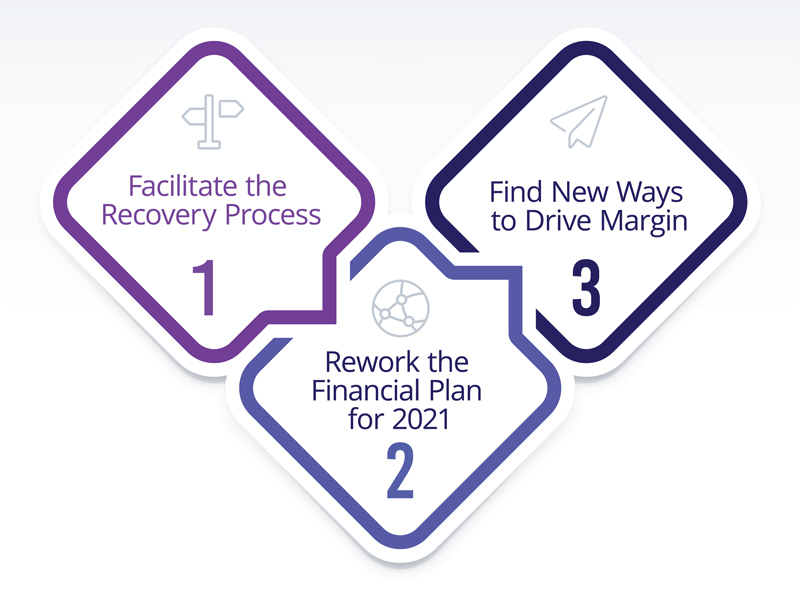Despite encouraging signs that we may be moving past the darkest days of the COVID-19 pandemic, widespread uncertainty remains. Will we see a spike in the fall? How quickly will the employment numbers and other economic indicators improve? How will the November election impact the market?
Without a crystal ball, finance teams must continue to be diligent, using all resources available to financial institutions to prepare for whatever may come.
As a financial performance management partner for banks, credit unions, farm credit associations, and other institutions, we are here to help you navigate whatever lies ahead. As you look to the remaining tasks for the year, it’s helpful to categorize them into three stages of financial planning during the COVID-19 pandemic:
- Facilitate the recovery process
- Rework the financial plan for 2021
- Find new ways to drive margin
Throughout the year, we will provide webinars and other resources to explore each of these stages.
1. Facilitate the Recovery Process
What are you doing now to position your institution for success? It’s important to gain a clear picture of where the institution stands and determine the potential impact of changing business conditions:
Assess financial damage and quantify the gap to plan
Market conditions have changed drivers for interest rates, pricing and growth plans for loans and deposits, margin versus fee-based income, credit quality, and more. How often do you reforecast? Many of our clients forecast at least monthly to accurately assess performance expectations, using variance reporting to compare actuals to plan.
Model the effect of potential change
Scenario planning can help your institution quantify the sensitivity to those same key drivers, managing risk and uncertainty more effectively. By taking the next logical step, defining potential plans for each scenario, your organization can react nimbly when conditions change. Data and technology deficiencies are commonly reported hurdles to scenario planning, including the ability to tie data sources together. One example is analyzing characteristics of the loan portfolio to understand that your institution has a large concentration of loans tied to the U.S. Treasury (UST) index, which in turn informs interest income modeling.
2. Rework the Financial Plan for 2021
The 2021 budgeting season is just around the corner. Finance teams need to evaluate how changing conditions will affect the plan. Will you invest in digital strategies? How do you anticipate branch operations changing? Will different products of emphasis make sense in the coming year?
To create a plan that works in these uncertain times, you need to:
Have a firm grasp of planning fundamentals
Is your team maximizing planning accuracy during volatility? Syntellis Performance Solutions recommends:
- Using a cash flow-based budgeting process to maximize the accuracy of net interest margin planning and cash flow projections.
- Including forecasted funds transfer pricing in the budget to better plan for margin changes by understanding expected net interest margin and income by initiative and segment.
- Deriving non-interest and expense values from balance sheet drivers to improve efficiency when changing assumptions while increasing understanding and buy-in from the field.
Ensure the right tools are in place
Will your planning solution provide the right data to inform business decisions? Does it shorten the budget cycle and streamline reporting to provide ample time for value-added analysis? What is your software return on investment? We can help you answer these questions.
3. Find New Ways to Drive Margin
To recoup losses and drive margin, you should have solid foundational knowledge around funds transfer pricing and profitability analysis (see our spring boot camp series). You should also identify key strategies for driving more margin.
Consider these areas of focus:
Boost portfolio performance in the current environment
This can be done by leveraging relationship data. Within the overall portfolio and those of individual relationship managers, quantifying the value of each relationship and understanding its components can help you retain your most valuable clients and improve the profitability of others. Pricing new business based on the profitability of the full relationship also helps you maximize portfolio profitability.
Incent staff for profitable growth
Don't focus just on higher volume, but also on aligning incentives to organizational goals. Provide appropriate plans for different roles within the institution, analyze new or modified plans in “what-if” scenarios, and ensure buy-in through visibility and accuracy in compensation plan calculations and supporting metrics.
In coming months, we will continue to provide valuable resources to support your journey from surviving to thriving as your institution negotiates the uncertainty.

